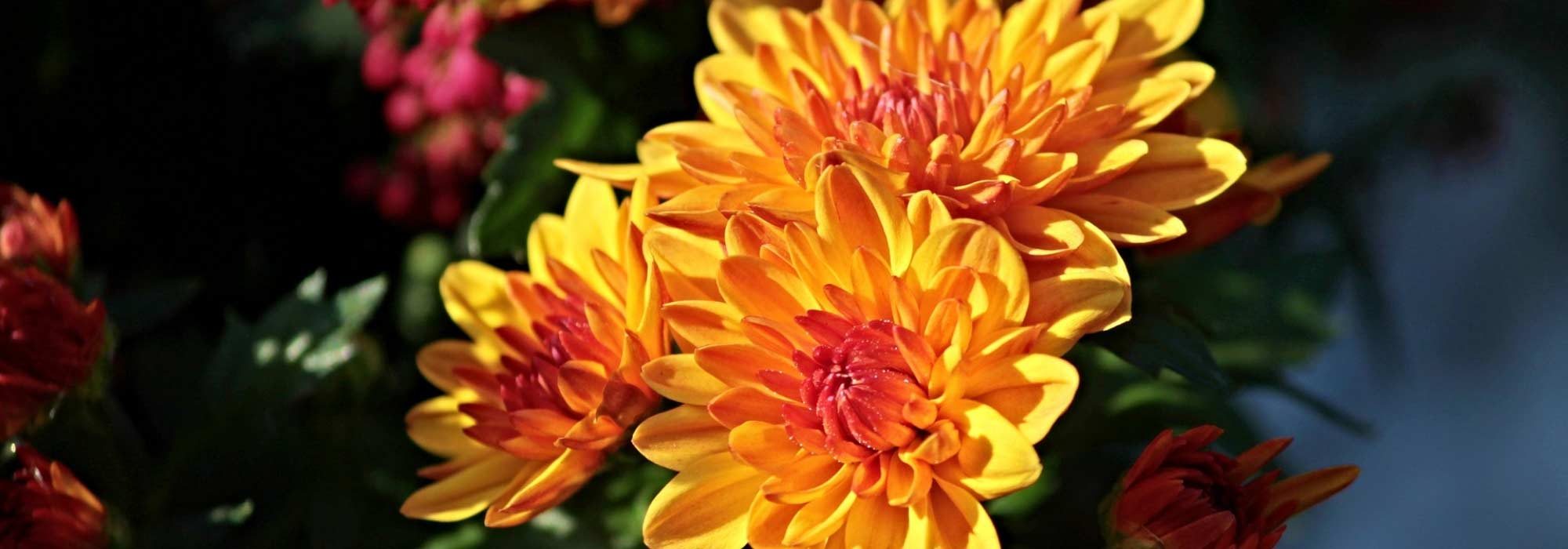
Chrysanthemum : planting, care and pruning
Contents
Chrysanthemum in a nutshell
- Chrysanthemum offers a profusion of flowers in warm and bright colours from June until the frosts
- Often associated with the decoration of graves, it is making a grand return to our gardens and terraces
- This king of autumn allows for colour in the garden right up to the edge of winter
- Often quite hardy, it is very easy to grow in full sun in rich, light, and well-drained soil
- It is essential in autumn containers, as well as in borders or summer and late-season bouquets
A word from our expert
With its old-fashioned charm and infinitely variable colours, the Chrysanthemum is making a remarkable comeback in recent years, once again gracing our gardens and autumn pots, to which it brings a rustic, romantic, or whimsical touch.
Long considered a symbol of cemetery flowers, with its single or round pompom flowers (the famous pomponettes of All Saints’ Day!), ranging from soft yellow to deep red, the chrysanthemum, far from this sad connotation, offers the beautiful advantage of shining brightly in autumn, at a time of year when other plants fade away.
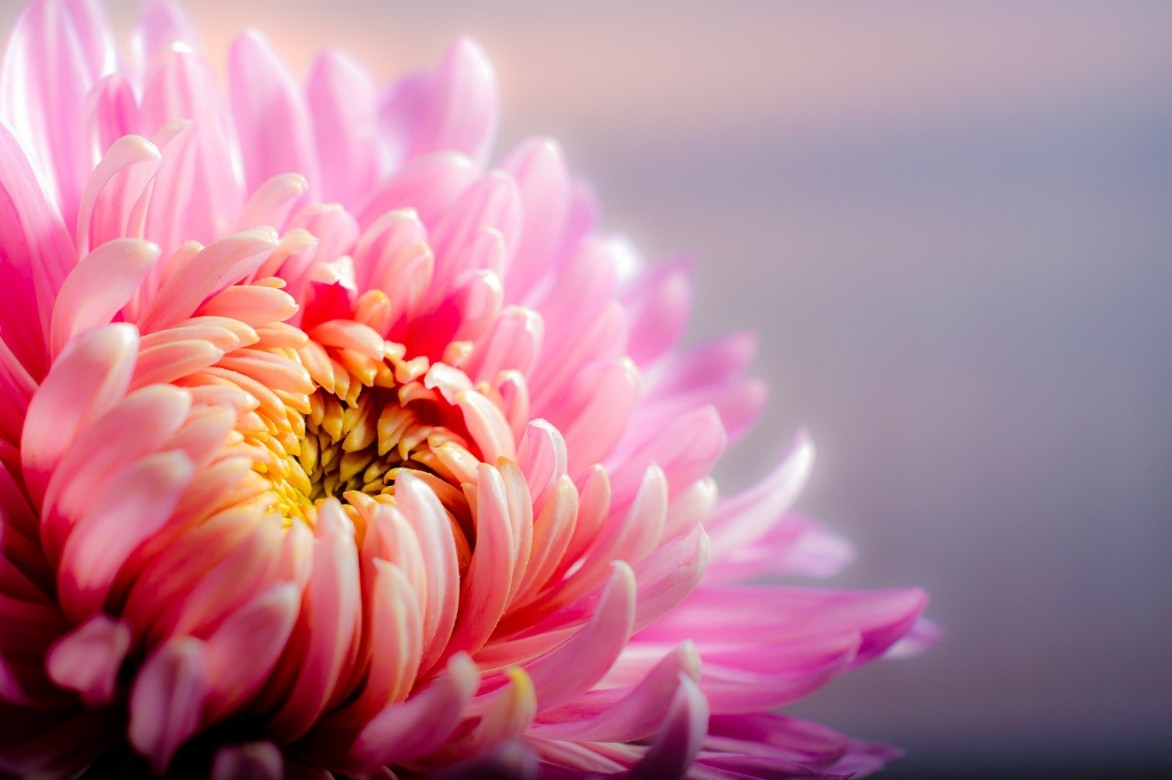
From florist chrysanthemums to autumn daisies, the genus encompasses many species of hardy perennial chrysanthemums that are very easy to grow (even indoors!) and are often hardy enough to withstand temperatures as low as -15°C.
Far from the symbolism of cemetery plants, discover our beautiful collection of chrysanthemums in soft and subtle or warm hues to maintain a floral decor, both in the garden and on balconies, until the onset of winter.
Description and botany
Botanical data
- Latin name Chrysanthemum
- Family Asteraceae
- Common name Chrysanthemum
- Flowering From June to November
- Height 0.30 to 1.50 m
- Exposure Sun
- Soil type All, well-drained
- Hardiness from -5°C to -15°C
Originating from Europe, China, or Japan depending on the species, the chrysanthemum, also known as “the daisy of the dead”, belongs to the large family of Asteraceae like the daisy. The genus chrysanthemum includes about twenty species, annual or perennial, growing in fields and stony fallow lands.
It is the florist’s chrysanthemum or autumn chrysanthemum, a result of cross-breeding between the species chrysanthemum indicum (Japanese chrysanthemum) and chrysanthemum morifolium which is the most cultivated in our gardens and flowers in cemeteries at All Saints’ Day. It has given rise to countless cultivars with flower shapes and colours that vary infinitely. We also often encounter hybrid autumn daisies (Chrysanthemum x rubellum), which are very hardy, originating from the Rubellum group.
The Chrysanthemum segetum or “corn chrysanthemum” and the keel chrysanthemum, also known as “Bluebell”, are annual species widespread in our countryside, flowers of harvested fields. The edible chrysanthemum (Glebionis coronarium) is also distinguished.
This herbaceous plant with a woody stump, sometimes rhizomatous, forms clumps with a very bushy, upright habit or slightly trailing and often well-ramified. Growing quite rapidly, the height of the chrysanthemum varies depending on the growing conditions and varieties from 0.30 m for dwarf chrysanthemums to 1.50 m for the most imposing varieties. The leaves appear in spring, alternating along semi-rigid, somewhat fragile woody stems. The deciduous or semi-evergreen foliage, depending on a mild winter, varies from one species to another, sometimes fine and deeply cut like its cousin the Bidens or more vigorous, resembling that of the daisy.
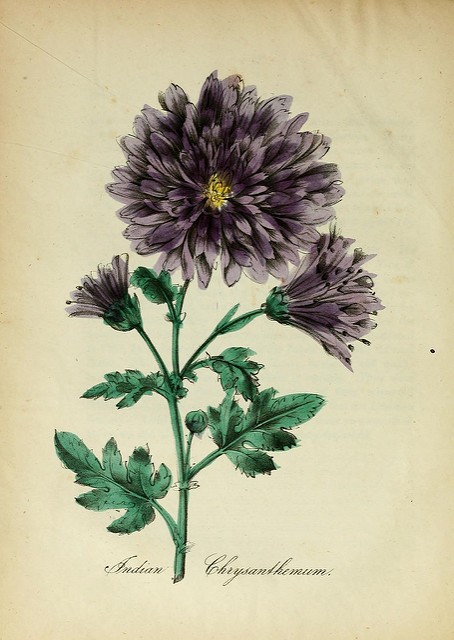
Chrysanthemum indicum – botanical illustration
The leaves measuring 5 to 15 cm in length are ovate to lanceolate, entire, lobed, or deeply cut especially towards the base, five-parted and generally dentate. Aromatic, they emit a strong musky scent when crushed. This dark green to glaucous blue or silvery foliage is often downy and villous underneath.
The abundant foliage highlights the rich colours and voluptuous shapes of chrysanthemum flowers.
The summer or autumn flowering is the main asset of the chrysanthemum.
The flowers of the chrysanthemum radiate like so many little suns. They possess such a strong character that they stand out among thousands and have the advantage of blooming at a time of year when other plants fade, hence their poetic nickname “autumn roses”. They most often begin to bloom when the days shorten.
The first chrysanthemums bloom as early as June, while the latest are still in full bloom in November. They are classified according to the flowering period: early, mid-early, or late (December-January). The plant then covers itself with numerous flowers, sometimes up to 50, in the form of a simple daisy or spherical pompon (“the pomponette”). The flower stems bear terminal inflorescences grouped in corymbs or solitary heads from 2 to 30 cm in diameter composed of ray florets.
Chrysanthemums differ by the shape of their simple, semi-double, or very double ligulate flowers; pompons, simple, incurved, spatulate, recurved, incurved-recurved… Pompon chrysanthemums offer globular, very compact, and very double flowers.
The shape of the ligules varies according to the cultivars: flat, tubular, and pipe-shaped, dentate at their tip, strongly curved towards the ground or conversely rolled upwards.
All bloom around a heart of tubular florets generally yellow or brown, sometimes purplish.
Originally golden yellow, they now come in an infinite variety of shades, from the warmest to the most delicate and soft: orange, garnet red to purplish red, violet, sunny yellow to apricot, pink, pure white, or apple green. Some chrysanthemums stand out for their bicolour or tricolour flowering (tricolour chrysanthemum ‘Polar Star’); the flower, often marked with a ring of a different colour, is coloured in contrasting tones from the heart to the periphery.

Chrysanthemum flowers: Chrysanthemum indicum ‘Poesie’, Chrysanthemum rubellum ‘Duchess of Edinburgh’, Chrysanthemum indicum ‘Last Sun’, Chrysanthemum rubellum ‘Clara Curtis’, Chrysanthemum rubellum ‘Mary Stocker’
These melliferous and fragrant heads exhale a unique scent that is both green, waxy, and earthy, reminiscent of chamomile, attracting the flight of foraging insects, sometimes until the gates of winter.
Its simple flowers in warm or subtle colours stand out in country bouquets heralding autumn.
Depending on the species, the chrysanthemum is cultivated in our country as an annual or most often as a fully hardy perennial (at least down to -15°C), capable of adapting to all regions.
It loves the sun and well-drained soils, rich and light, not too dry to moist. It does not appreciate acidic soils, too calcareous, and too heavy as it is very sensitive to excess water.
Versatile, the chrysanthemum brightens up beds, borders, mixed borders, but also pots, containers, and window boxes on balconies and terraces. A sacred flower in Japan, the chrysanthemum is the symbol of the imperial family and the national emblem. It is also used as a medicinal plant and to make chrysanthemum tea. Cultivated in cemeteries for All Saints’ Day pots, it also symbolizes immortality.
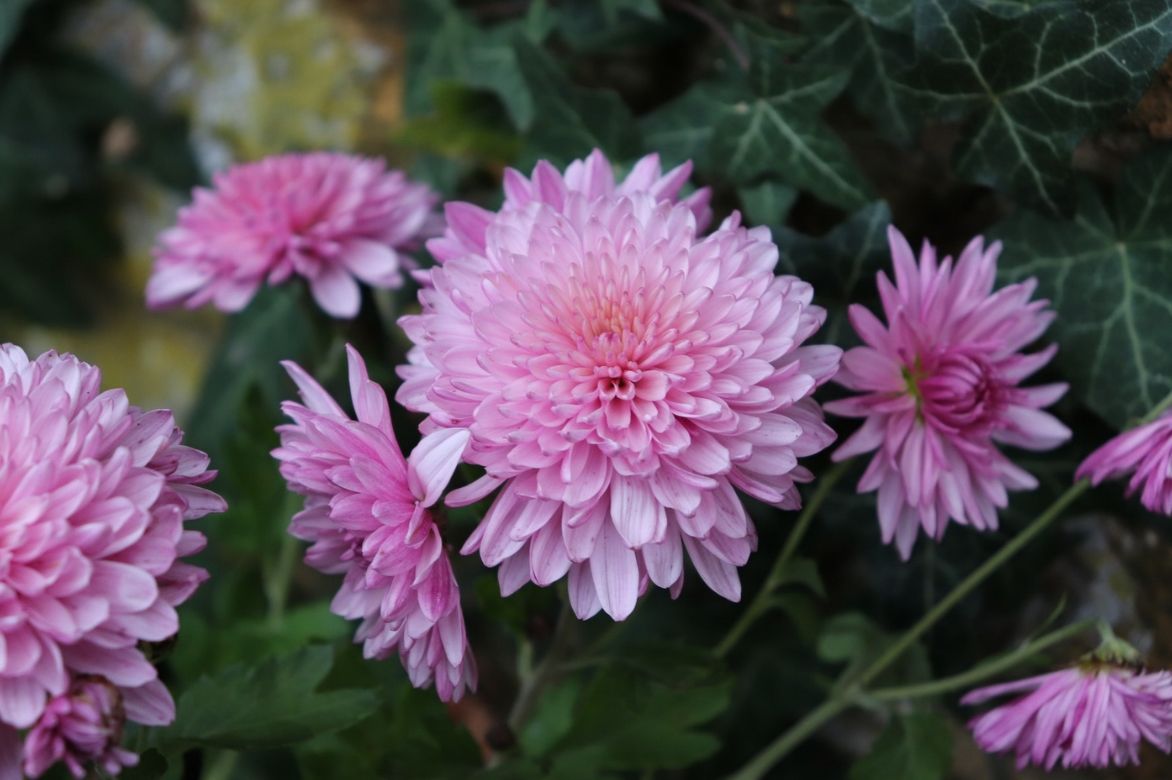
Stunning soft pink and well-double flowers of Chrysanthemum indicum ‘Orchid Helen’
Main species and varieties
The chrysanthemums most commonly found in our gardens are the florist chrysanthemums or autumn chrysanthemums (Chrysanthemum hortorum), which are the result of a cross-breeding between the species chrysanthemum indicum and chrysanthemum morifolium.
They have given rise to numerous cultivars with single or double flowers (the famous pomponettes of All Saints’ Day) that bloom from late summer until the first frosts. These are perennial plants available in a wide range of shapes and shades, cultivated for the garden, as well as for cut flowers and for All Saints’ Day pots.
Autumn daisies or Rubellum from C. rubellum are among the hardiest chrysanthemums, and they come in countless varieties with very diverse colours.
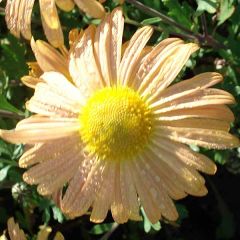
Chrysanthemum Mary Stoker
- Flowering time October to December
- Height at maturity 60 cm

Chrysanthemum Duchess of Edinburgh
- Flowering time October to December
- Height at maturity 1 m
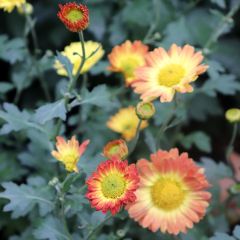
Chrysanthemum rubellum Last Sun
- Flowering time September to November
- Height at maturity 60 cm
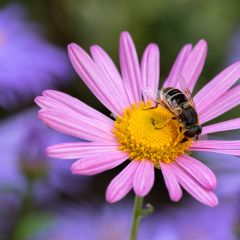
Chrysanthemum rubellum Clara Curtis
- Flowering time September to November
- Height at maturity 60 cm
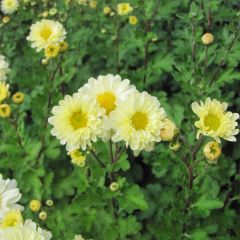
Chrysanthemum Poesie
- Flowering time October to December
- Height at maturity 1 m
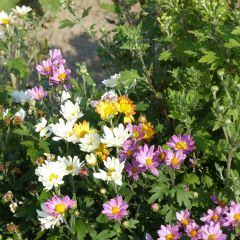
Chrysanthemum Fanfare Improved F1 Seeds
- Flowering time October to December
- Height at maturity 60 cm

Chrysanthemum carinatum - Painted Daisy Sunset Seeds
- Flowering time July to October
- Height at maturity 60 cm

Summer Festival Keel Chrysanthemum - Chrysanthemum carinatum seeds
- Flowering time July to October
- Height at maturity 65 cm
Discover other Chrysanthemum
View all →Available in 1 sizes
Available in 1 sizes
Available in 2 sizes
Available in 2 sizes
Available in 1 sizes
Available in 2 sizes
Available in 1 sizes
Available in 1 sizes
Available in 2 sizes
Available in 1 sizes
Planting
Where to plant Chrysanthemums?
Very easy to grow, generally exhibiting good hardiness (at least down to -15°C in well-drained soil), the perennial Chrysanthemum or autumn daisy (the pompons and Rubellum) grows almost everywhere in France and adapts to all climates. It withstands drought and the spray of maritime climates well. Once well-rooted, it remains in place from one year to the next, potentially self-seeding.
The least hardy varieties or the latest cultivars will be grown as annuals in pots, possibly stored indoors during winter under a veranda or a cold greenhouse in harsh climates, and brought out in May for the beautiful season. Although hardy, annual Chrysanthemums are short-lived perennials that will need to be replanted each year.
The Chrysanthemum requires a sunny position and can adapt to almost any soil, although it prefers a light, fertile, neutral to slightly acidic soil, not too dry but moist; just avoid very acidic or very calcareous soils. It must be planted in well-drained soil, as it does not thrive in heavy, wet soils during winter.
Provide a stake to support the taller forms.
Essential in a country garden or a wild garden, the Chrysanthemum is a versatile floriferous perennial that brings colour, texture, and originality. It is best planted in groups in the middle or foreground of a sunny border, associated with grasses and other autumn perennials that will provide support, preventing the flowering stems of the tall and bushy varieties from flopping over unsightly.
The annual Chrysanthemums are indispensable in a wildflower garden.
With their rapid growth, they fill gaps in perennial borders or other annual plants and allow for a floral display until the onset of winter. The dwarf varieties, the dwarf chrysanthemums for borders, are reserved for generous and abundantly flowering borders, window boxes, and large pots where they will form magnificent, neat balls of colour.
When to plant Chrysanthemums?
Planting of the Chrysanthemum takes place in spring from March to May or in autumn from September to November, avoiding periods of frost or drought.
How to plant Chrysanthemums?
In the Ground
To bloom well, the Chrysanthemum appreciates rich soil: add a spadeful of compost or well-decomposed manure at planting and improve drainage in heavy soils with some river sand or gravel.
Maintain a distance of 30 to 50 cm between plants depending on their adult size and count 3-5 buckets per m² for a beautiful decorative effect. It can be used in large masses, either alone or mixed with other perennial or seasonal plants.
- Prepare the soil well
- Make a good gravel bed at the bottom of the hole
- Position the root ball and backfill with some river sand and compost
- Mulch with pine bark to keep the soil cool during summer
- Water regularly after planting until established
In Pots
Plant the Chrysanthemum in a large pot or window box at least 20 cm deep in a mixture of good potting soil for flowering plants, loamy soil, and sand or gravel. Pinch it often to give it a compact habit. Water twice a week but without excess, allowing the substrate to dry out between waterings.

To learn more about pot planting, read our advice sheet: Growing a Chrysanthemum in a Pot.
When and how to sow Chrysanthemum?
The perennial chrysanthemum is sown indoors in a warm environment from October to March. The annual chrysanthemum seeds are sown in a cold frame from February onwards, or directly in place after the frosts from April to June. An autumn sowing allows for earlier flowering.
Indoors
- Sow your chrysanthemum seeds generously in a tray filled with good seed compost
- Lightly cover the seeds with compost
- Firm down and water thoroughly with a fine spray
- Place the seedlings in light, without direct sunlight, at a temperature of 15°C to 20°C
- Transplant the seedlings when they are about 5 cm tall into 8 cm buckets
- Pinch the tips of the stems of young plants when they reach 15 to 20 cm, to encourage them to ramify
- Plant your young plants in the garden or in larger pots in the sun at the end of May when the temperature is warm enough
Sowing Outdoors
- In well-worked soil enriched with compost, sow your seeds generously when all risk of frost has passed
- Lightly cover them with compost without burying them deeply
- Firm down
- Water thoroughly with a fine spray
- Thin the rows slightly by keeping only one plant every 30 to 40 cm
- Then, when the plants reach 15 to 20 cm in height, pinch the tips of the stems to encourage the plant to ramify
The sowing of chrysanthemums will hold no secrets for you thanks to our tutorial.
How to care for chrysanthemums?
Easy to grow, Chrysanthemum requires very little maintenance. Only a few actions are necessary for its proper development.
Water without excess 1 to 2 times a week only when the soil is dry and especially in case of drought at the base of the plant and not on the foliage.
In pots, watering should be more regular but always moderate.
A rather fertile soil will promote its full blooming: in spring or autumn, add one or two shovelfuls of well-matured compost at the base and during growth a liquid fertiliser rich in potash every eight days until the buds colour.
To prevent the stems from getting damaged, support the tall varieties especially in windy areas. At the end of autumn, cut back the clumps.
In regions with mild winters, leave the plants in place under the protection of a thick dry mulch of dead leaves or straw.
In regions with harsh winters, bring the most tender Chrysanthèmes in from frost and rain (at 8-10°C minimum), water them sparingly during winter and take them out again in May.
If you leave them outside, wrap them in a winter fleece.
Every 2 to 3 years, in spring or autumn, divide the well-established clumps to rejuvenate them and restore vigour.
→ Discover how to prune and pinch the Chrysanthèmes in our tutorial!
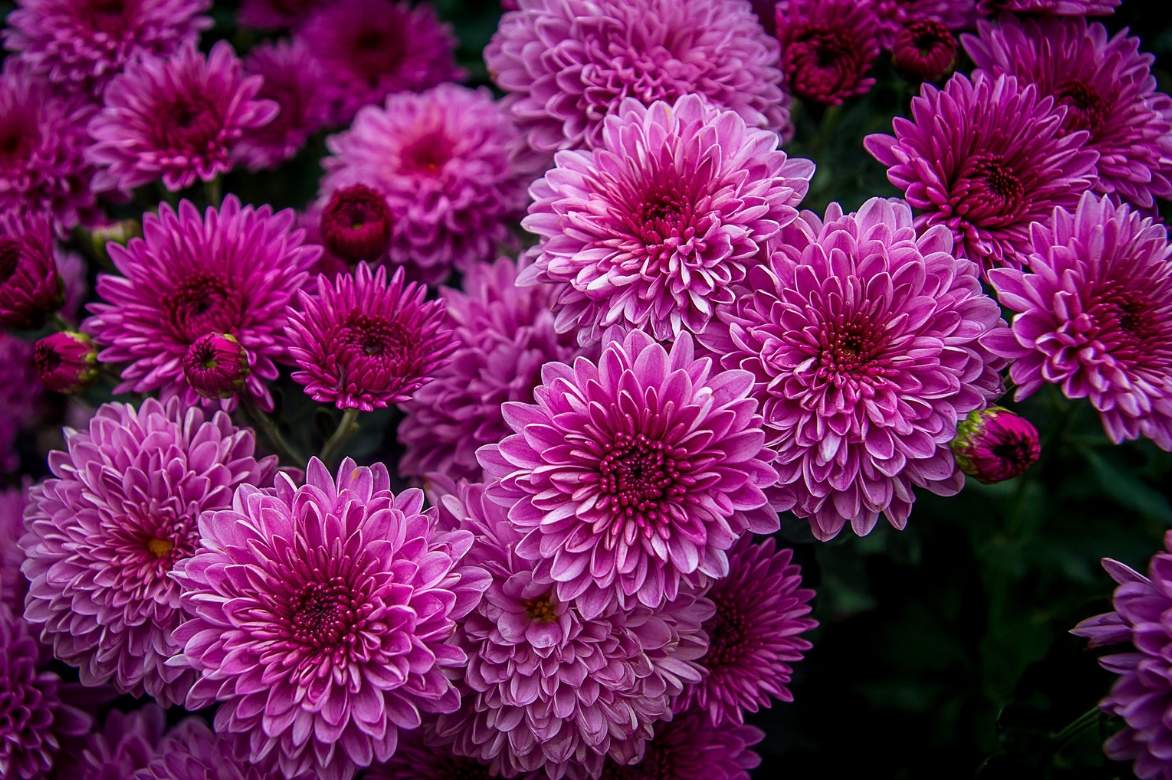
How to prune and pinch chrysanthemums?
Two to three weeks after planting, pinch the tips of the terminal shoots of your Chrysanthemums to encourage the branching of secondary shoots: this will thicken the habit of the plant, making it more resistant to the elements and possibly eliminating the need for unsightly staking. Discover on our blog a green pruning technique for perennials that is practiced from mid to late May.
- During the summer, to achieve larger flowers, pinch off the flower buds on the lateral shoots
- Remove faded flowers to encourage the appearance of new blooms and extend the flowering period
- To obtain a sturdier plant, keep only 5 to 8 strong shoots and in June, cut back the young shoots to 10 to 15 cm
- A cut back in spring in March, to 30 cm above the soil, will help maintain a compact and well-branched habit
Diseases and potential pests
Chrysanthemum is particularly vulnerable in heavy, poorly drained soil that is too wet in winter. Under these conditions, in spring or late summer, it can be sensitive to powdery mildew, which is characterised by a white fluff on the leaves. As a preventive measure: water at the base without wetting the leaves and spray with horsetail decoctions, nettle manure, or Bordeaux mixture. In case of infection: remove and burn the affected parts.
In winter, if your soil is too wet, grey rot (Botrytis) can threaten its roots: pull up the affected clumps.
Rust can develop on potted plants’ leaves when the soil is not fertile enough or is too nitrogen-rich.
Chrysanthemums can be infested with aphids: make sprays of water mixed with black soap.
In case of an attack by red spider mites visible on the undersides of the leaves: maintain a humid atmosphere around the potted plants.
Multiplication
When and how to divide chrysanthemum clumps
Chrysanthemum easily multiplies by dividing clumps in March or after flowering. Practice on well-established mature clumps.
- Gently lift the root ball with a fork
- Separate a few clumps with roots
- Replant these parts immediately in the garden in well-worked soil
When and how to take chrysanthemum cuttings?
- In early spring, around April-May, take leafy stem tips about 10 cm long
- Cut just below a leaf, and remove the lower leaves
- Insert the cuttings into small buckets filled with an equal mix of potting soil and sand
- Place them in light under heated shelter (between 16 and 18 °C)
- Repot when they reach 12 cm
- Pinch them to encourage the formation of flowering branching
- After heavy frosts, transplant into the ground or pots, spacing the young plants 20 to 30 cm apart
Discover our tutorial to learn how to propagate chrysanthemums.
Associations
With their old-fashioned charm, their somewhat rustic character, their shapes and colours varying infinitely, Chrysanthemums are essential in country gardens, flowering vegetable patches, colourful mixed borders, and naturalistic scenes.
Chrysanthemums have the huge advantage of bringing late colours at a time of year that is somewhat less floral, with their flowering extending from mid-summer until the first frosts, or even later. They will revive the beds deserted by summer blooms in pastel or vibrant combinations.
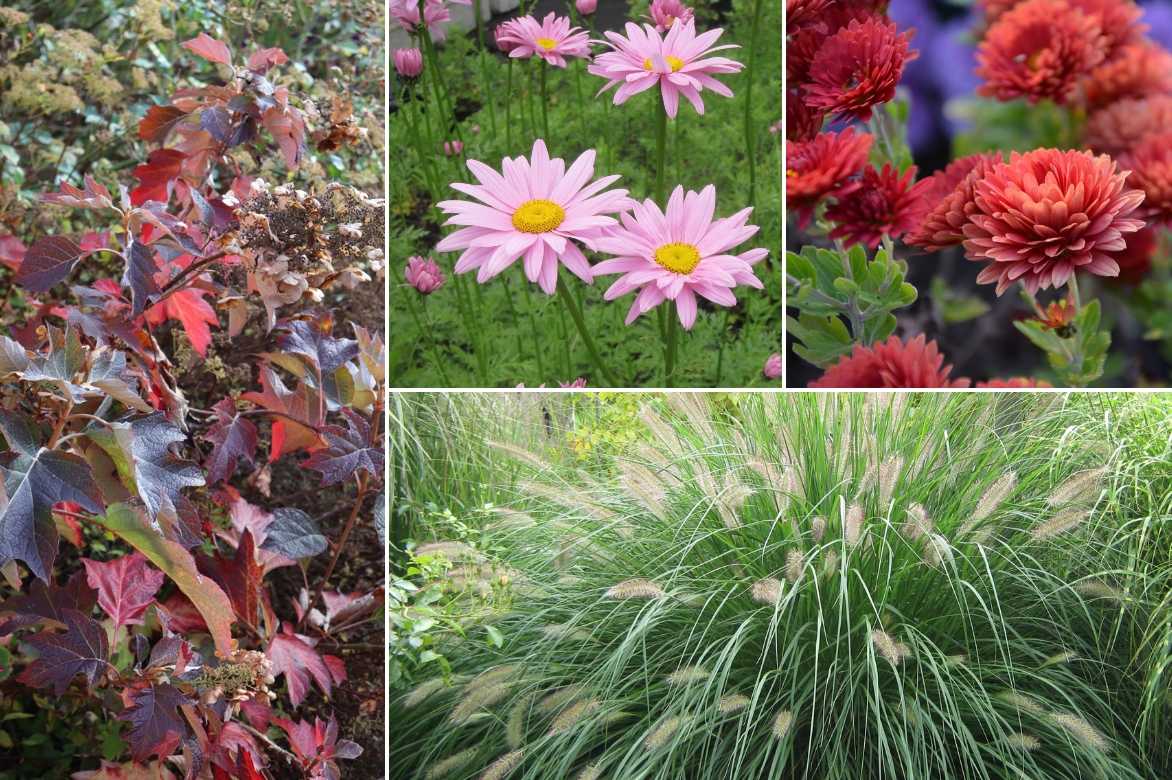
An idea for a bed association: Hydrangea quercifolia ‘Burgundy’ (similar variety ‘Snowflake’), Chrysanthemum rubellum ‘Clara Curtis’, red Chrysanthemum (similar variety ‘Duchess of Edinburgh’), Pennisetum alopecuroïdes f. viridescens (or ‘Red Button’)
Their blooms will be lightened by those of cosmos, gauras, Japanese anemones, shrubby salvias, Fuchsia magellanica…
Perennials with strong growth (Asters, Echinaceas, Cannas, Daylilies, Kniphonias) will act as supports, preventing their flowering stems from flopping unattractively in a richly flowering bed.
What a lovely idea it is to use grasses to highlight the strong character of the chrysanthemum flower! A mix with subtle charm from the beginning to the end of summer. All Chrysanthemums integrate within a profusion of light grasses in straw tones like Pennisetum or foxtail grass with large silky spikes, a Carex, a Miscanthus, a Stipa pennata, or a Hordeum jubatum or foxtail barley.
Asters are also good companions for chrysanthemums with flowers in shades of red-violet, crimson, carmine, white, or soft yellow for complementary colour play.
In a border, large clumps of chrysanthemums will be highlighted by saxifrages and lady’s mantle.
In a bed with spicy tones, mix in some clumps of brightly coloured red and orange Chrysanthemums with a Echinacea purpurea (‘Summer Salsa’), autumn heleniums, gaillardes, Helichrysum, crocosmias, or even a heuchera ‘Ginger Ale.’
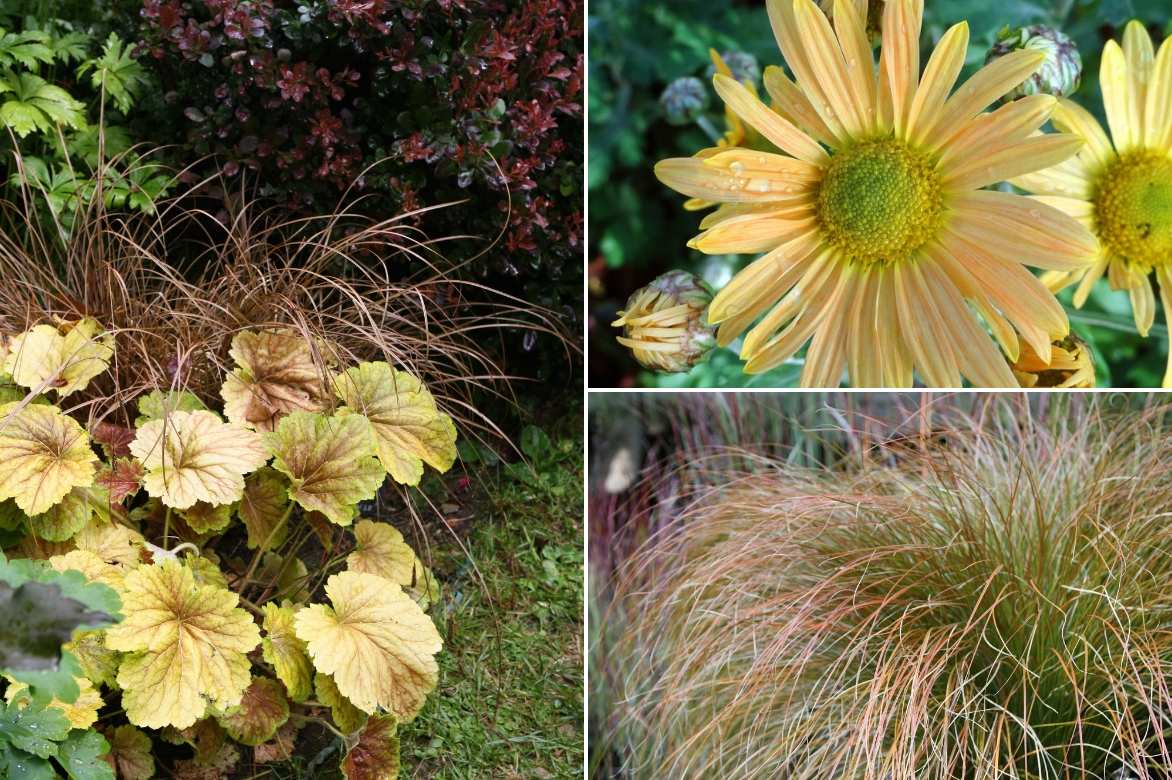
An idea for a spicy association: Chrysanthemum rubellum ‘Mary Stocker’, Berberis thunbergii ‘Atropurpurea Nana’, Carex comans ‘Bronze Form’, Carex testacea ‘Prairie Fire’ and orange heuchera like the variety ‘Ginger Ale’
A mix of saturated colours suits the late season well: pair the pink-flowered varieties of Chrysanthemums with the fuchsia pink balls of Dahlias and Cleomes. They will be perfect in the foreground of Fox-tail Amaranths, a Smoke Tree or a Castor Bean that will add flair in autumn.
They also pair well with the highly defined flowers of dahlias and gladioli, contrasting with their powerful accents.
In a pot, combine them with bright orange tagetes, zinnias, miniature dahlias mixed with the spikes of small feathery grasses.
Essential for summer or late-season bouquets, whether simple daisies or mini pompons, Chrysanthemum flowers make excellent cut flowers when paired with dahlias or everlasting flowers.
Useful resources
- Chrysanthemums are the kings of autumnal atmospheres: discover 5 ideas for pairing chrysanthemums!
- In a country house or in a naturalist garden, chrysanthemums fit into all decors.
- In a colourful mixed border, in a romantic bed or with Catalan inspiration, depending on their warm or pastel shades, chrysanthemums are a must-have for autumn.
- Tutorial: How to sow chrysanthemums?
- Tutorial: How to propagate chrysanthemums?
- Advice sheet: Growing a chrysanthemum in a pot and Pomponette chrysanthemums: perfect for autumn beds
- Tutorial: How to dry chrysanthemum flowers?
- Chrysanthemums by flower colour: The top 5 red-flowered chrysanthemums; 5 chrysanthemums with yellow or orange flowers, 5 chrysanthemums with pink flowers
- Rediscover chrysanthemums, iconic flowers of autumn.
- Our advice sheets: Florist chrysanthemums, garden chrysanthemums: what’s the difference? and Autumn garden: everything you need to know to successfully grow hardy chrysanthemums
- Subscribe!
- Contents
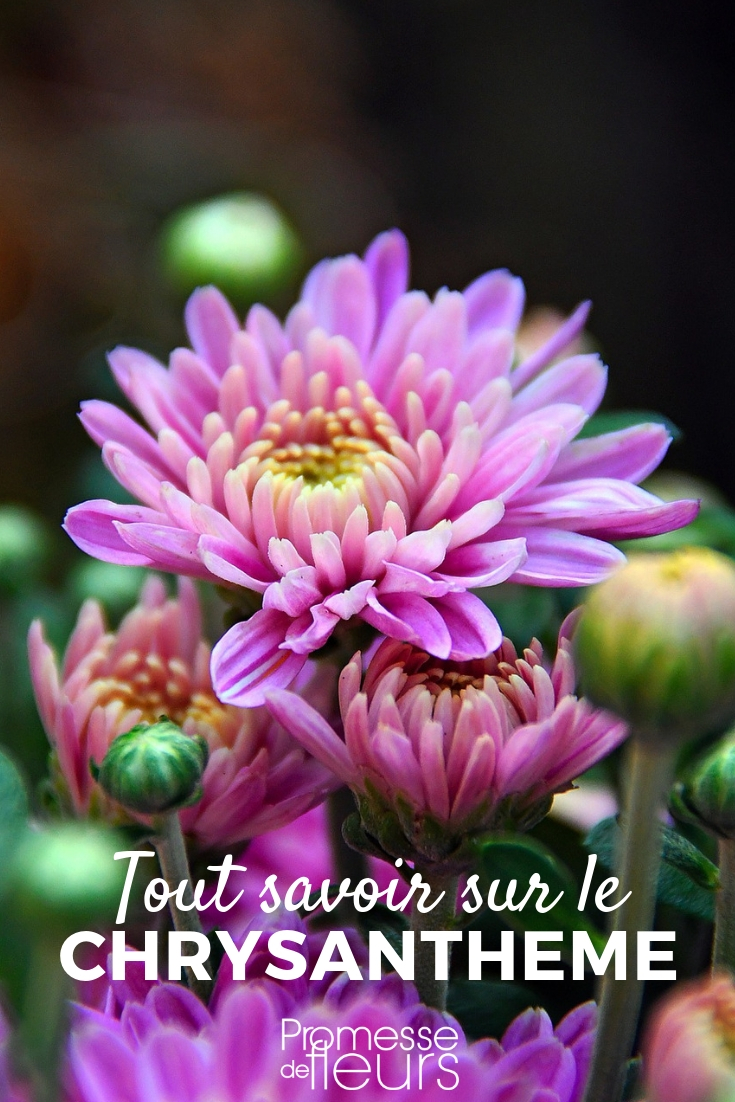































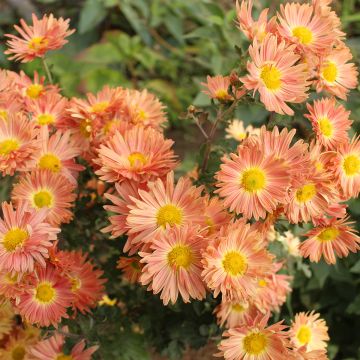
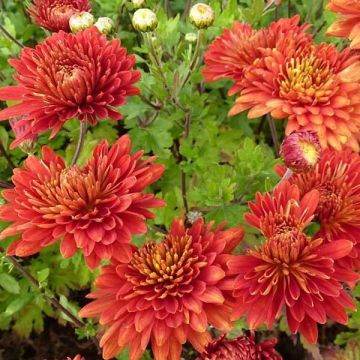

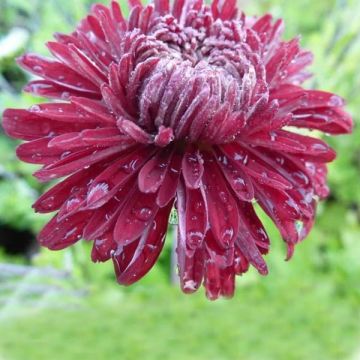
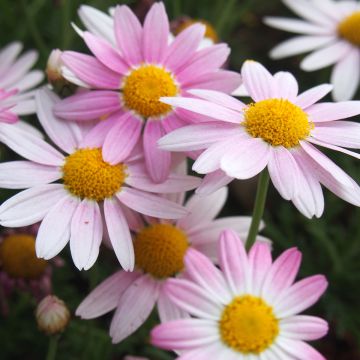

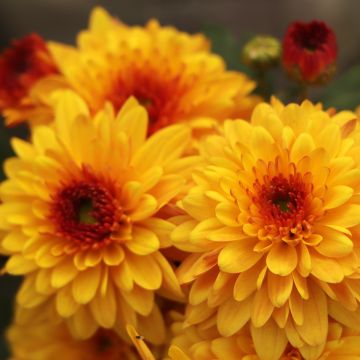
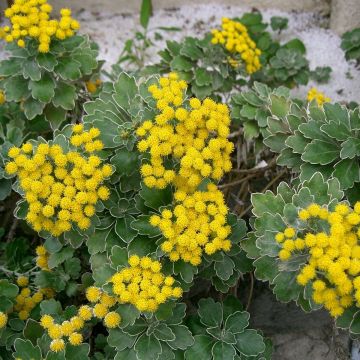
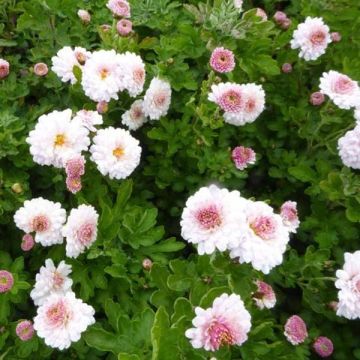
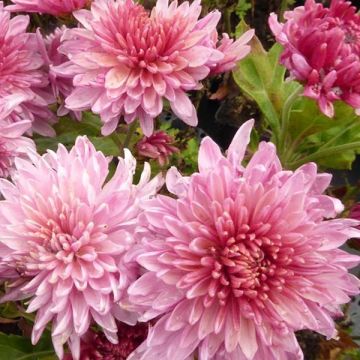
Comments